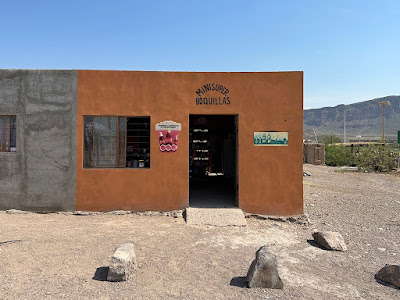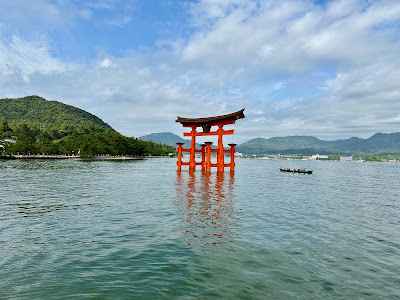At the end of June I made a quick trip to Texas to see friends and to pay a visit to Big Bend National Park. This was perhaps not the best laid out plan for a trip that I have ever done - Big Bend is in Southern Texas along the border with Mexico and this year the temperatures at the end of June were exceedingly high.
The drive from Houston to Big Bend was also a little longer than I had expected. It is 600 miles and that is an extreme drive to try and do in a single day. The countryside along the way is not so interesting either. It is relatively flat and to be honest - boring.
 |
| Sanderson, Texas |
I stopped to look around in the town of Sanderson. It is advertised on a billboard outside the town as the Cactus Capital of Texas. It doesn't look that prosperous of a town, maybe it was at one time. Recent attempts to rebuild it do not look to be working either. That being said it is an Amtrak stop and you can get a train to New Orleans, LA or Chicago.
My destination for the first night was Lajitas, just outside the park. There's a golf course there and a resort of sorts but not much else. After 600 miles of driving it was a welcome stop for a beer, food and a bed.
 |
| The Rio Grande outside Lajitas |
The next morning after breakfast at the hotel I set off on the road through the Big Bend Ranch State Park (different to the National Park) on the road to Presidio. Initially the road follows the Rio Grande valley. I was quite surprised to find that the Rio Grande is not such a major river. There are many places that you could walk across quite easily
 |
| Contrabando Movie Set |
It passes by Contrabando, the old movie set that has been used for several movies like Lone Star and Lonesome Dove. There is not much left of the sets buildings following a recent flood.
The road reaches the town of Presidio which is the small town across from the larger Mexican town of Ojinaga. Presidio didn't seem to have much to offer. It is pretty desolate.
 |
| Border Control Checkpoint |
Heading north from Presidio towards Marfa there is a border control checkpoint on the road where all cars and trucks are stopped looking for illegal immigrants and possibly contraband. Being a single white guy I was allowed through.
Marfa is an interesting little town. It has become something of an arts center with several galleries, art installations and the like. It has a history as a movie location - the James Dean, Elizabeth Taylor movie Giant, No Country for Old Men and There Will Be Blood all being shot there.
 |
| The Hotel Paisano, Marfa |
The old hotel, the Paisano, which was once the headquarters for the filming of Giant, is a beautiful building and no doubt the place to stay. The County Court House in the main square is also impressive.
 |
| Giant Billboards - Liz Taylor, James Dean |
Outside town there are a series of billboards showing James Dean and Elizabeth Taylor in their Giant roles. There's a solar powered music system that plays country music by Mike Nesmith (of the Monkees).
 |
| Tethered Aerostat Radar System |
Further out along the highway there is an installation of a fairly large dirigible. It is part of the Tethered Aerostat Radar System. Presumably for detecting any unusual and illegal activity along the border.
 |
| Prada, Marfa |
Further west just outside the exceptionally small and decrepit town of Valentine is another art installation. A Prada shop sitting by the side of the road miles from anywhere in the desert landscape complete with fine shoes and handbags. Sadly it looks like there was some vandalization.
 |
| Chisos Basin Lodge |
From Marfa, the road went through Alpine and Marathon and down into the National Park. Lodging that night was at the Chisos Basin Lodge, the only hotel in the park. It was a basic room but it was in a great location, in the center of this basin surrounded by majestic hills.
 |
| The Mule Ears |
 |
| Santa Elena Canyon |
Santa Elena Canyon was quite spectacular. There was a little too much water for me to want to cross and go up the canyon. I didn't have adequate water shoes.
I finished off the evening by driving to Terlingua for dinner and to fill up the tank with gas.
The next day there was only one part of the park left to see and that was the Boquillas area. Boquillas is in the south east corner of the park. There is a Visitor Center there (closed because we are out of season), a campsite, and a crossing of the Rio Grande where you can go into Mexico.
It is quite an informal border crossing. Before 9/11 it was quite informal - no customs, no control, you just walked across or got a boat across. After 9/11 they closed the border only to reopen it in 2018 or 2019 with some controls provided by the Parks Service. All you need is a valid US passport.
 |
| Ferry to Boquillas del Carmen |
I checked out at the border control station and walked down the trail to the river. The river is quite shallow and you could wade across the 1 - 2 ft deep water. However the Mexicans have a little tourist business going and they charge $5 to ferry you across in a row boat.
 |
| The trail to the Boquillas |
On the other side it is a short dusty walk of around 0.75 miles up to the village of Boquillas del Carmen. In the peak season there are a a few hundred tourists crossing each weekend day but June is not the peak season. I believe there were 7 people who made the crossing on the day I was there. There were donkeys and horses galore to carry you up the hill for a price but I felt like a walk.
 |
| Bars, Churches and Tourist Shops, Boquillas |
The town itself is quite poor - dirt streets, decrepit housing. The main and perhaps only industry is tourism. There were lots of stalls selling crafts and wares for the tourists. Sadly nothing I wanted to buy. After a walk around town and a Coca Cola in a cafe I went back down to the river and was ferried back across.
In the border station the Park Ranger fed my passport information into a computer and passed the information on the the Customs people in El Paso who then gave me approval to come back to the US.
 |
| Boquillas Canyon Trail |
It was now around midday and it was getting seriously hot. At least 110 degrees with quite a bit of humidity. There was one more thing I wanted to do and that was to hike into Boquillas Canyon. It was a short hike - less than 2 miles each way. However it was getting hotter all the time. Where the trail ended I took to the river to cool off. The water was a foot deep at the most and really it wasn't very cooling; it was warm water. I had to walk across the river into Mexico again, just because I could and because there was no one around to stop me.
 |
| The Rio Grande in Boquillas Canyon |
On the way back I was feeling quite affected by the heat. I have run in the Sierras in the heat many times and thought I knew how to handle heat on a short hike but this was totally different. The heat and the humidity were quite draining and it could be quite dangerous. When I got back to the car it was 114 degrees - no country for old men. The next day a 14 year old boy died on the trail from the extreme heat. Apparently no country for young men either.
This was now the end of my visit to Big Bend. Hiking was out of the question in the heat and all the drivable sites in the park had been visited. Midland provided a better option for returning to California being only 3 hours away compared to Houston's 10 hours so I switched my travel plans and drove to Midland.
West Texas is not particularly inspiring and it was a fairly boring drive to Midland. The section of I-10 between Odessa and Midland was a little unsettling. It was rush hour on a Friday evening, it was 112 degrees outside, the freeway was surrounded by industrial buildings for the entire distance, there were oil pumps everywhere, and a dust storm was brewing. I am not sure I could live there.
 |
| The George Bush Childhood Home |
The next morning before my flight I went to the George W. Bush childhood home which is now a museum. He grew up in a very modest 1940's, 1950's home and it has been renovated to it's condition at the time he grew up there. Quite interesting. His father, George H. W, was the hard working entrepreneur - schlepping his family around the country while he built his oil business.
 |
| The Midland Petroleum Museum |
On the way to the airport I stopped at the Petroleum Museum. As an ex oil person I found it quite interesting. Midland and the surrounding Permian Basin has been and still is a significant force in the petroleum business. Interestingly there was mention of the recent developments in energy like nuclear, solar and geothermal but no mention of global warming, except for a book questioning the validity of it being sold in the book shop.








































